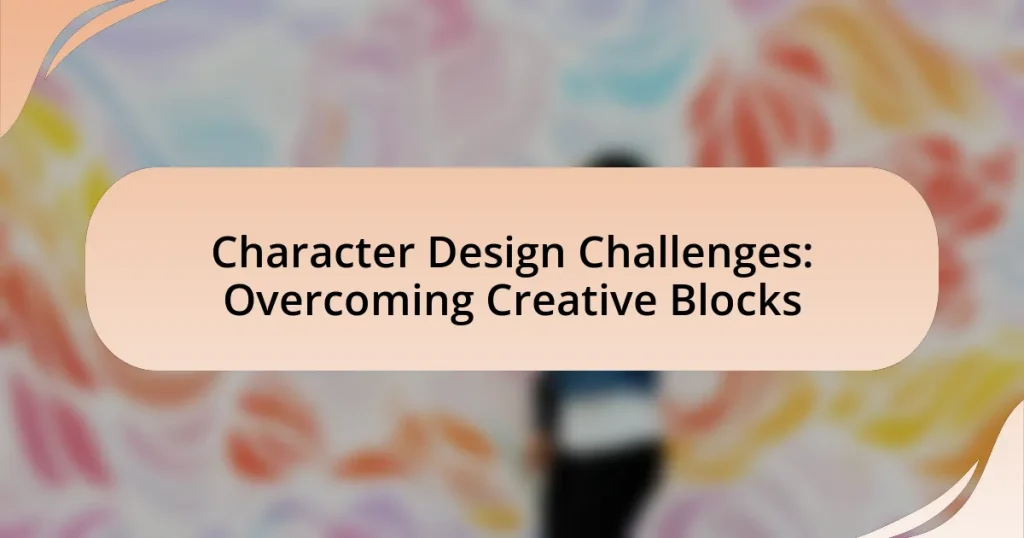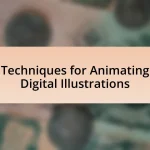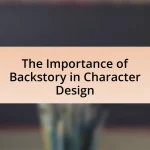The article focuses on the common challenges faced in character design, particularly the issues of originality, consistency, and the balance between aesthetics and functionality. It explores how creative blocks manifest in this field, influenced by psychological factors such as fear of failure and perfectionism, as well as external pressures like deadlines and market trends. The discussion includes strategies for overcoming these blocks, such as brainstorming techniques, seeking feedback, and utilizing various resources, while also highlighting the importance of maintaining a creative mindset and regular practice to enhance character design skills.
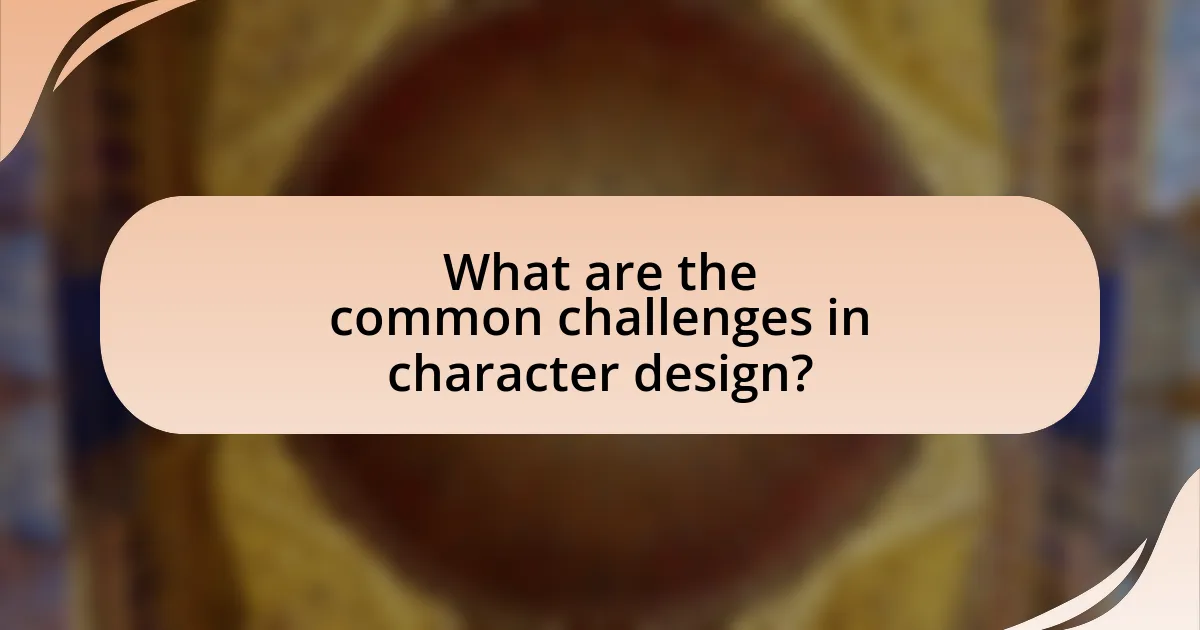
What are the common challenges in character design?
Common challenges in character design include achieving originality, maintaining consistency, and balancing aesthetics with functionality. Originality is crucial as designers strive to create unique characters that stand out; however, the saturation of existing designs can make this difficult. Consistency is essential for ensuring that characters remain recognizable across various poses and expressions, which can be challenging when working with complex designs. Additionally, balancing aesthetics with functionality requires designers to consider how a character’s appearance aligns with their role and abilities within a story, which can complicate the design process. These challenges are frequently encountered in the industry, as evidenced by the need for iterative design processes and feedback loops to refine character concepts effectively.
How do creative blocks manifest in character design?
Creative blocks in character design manifest as an inability to generate new ideas, leading to stagnation in the design process. Designers may experience frustration, self-doubt, and a lack of inspiration, which can hinder their ability to conceptualize unique characters. Research indicates that these blocks often arise from external pressures, such as deadlines or critical feedback, as well as internal factors like perfectionism or fear of failure. For instance, a study published in the Journal of Creative Behavior highlights that artists frequently encounter mental barriers when they feel their work does not meet their own standards or the expectations of others.
What are the psychological factors contributing to creative blocks?
Psychological factors contributing to creative blocks include fear of failure, perfectionism, and self-doubt. Fear of failure can paralyze individuals, preventing them from taking risks necessary for creativity. Perfectionism leads to unrealistic standards, causing anxiety and inhibiting the creative process. Self-doubt undermines confidence, making it difficult for individuals to trust their creative instincts. Research by Flett and Hewitt (2002) indicates that high levels of perfectionism correlate with increased anxiety and decreased creative output, reinforcing the impact of these psychological factors on creative blocks.
How do external pressures affect creativity in character design?
External pressures can significantly hinder creativity in character design by imposing constraints that limit artistic freedom. For instance, deadlines, client expectations, and market trends can force designers to prioritize commercial viability over innovative ideas. Research indicates that when designers feel pressured to conform to specific guidelines or trends, their ability to explore unique concepts diminishes, leading to a reliance on clichés or established formulas. A study published in the Journal of Creative Behavior found that high levels of external pressure correlate with decreased originality in creative outputs, highlighting the detrimental impact of such pressures on the character design process.
Why do artists struggle with originality in character design?
Artists struggle with originality in character design primarily due to the overwhelming influence of existing styles and tropes in popular culture. This saturation creates a challenge for artists to develop unique concepts that stand out while still appealing to audiences. Research indicates that cognitive biases, such as the “mere exposure effect,” lead artists to unconsciously replicate familiar designs, making it difficult to break free from established norms. Additionally, the pressure to meet commercial expectations often forces artists to prioritize marketability over innovation, further stifling originality.
What role does comparison with other artists play in creative blocks?
Comparison with other artists often exacerbates creative blocks by inducing feelings of inadequacy and self-doubt. When artists measure their work against the perceived success or skill of others, it can lead to a paralyzing fear of not meeting those standards, which stifles their creative expression. Research indicates that social comparison can negatively impact self-esteem and motivation, as highlighted in a study published in the Journal of Personality and Social Psychology, where individuals who frequently compared themselves to others reported higher levels of anxiety and lower levels of creativity. This dynamic creates a cycle where the fear of judgment and the pressure to conform to external benchmarks hinder the artist’s ability to innovate and produce original work.
How can fear of criticism hinder character design creativity?
Fear of criticism can significantly hinder character design creativity by causing designers to second-guess their ideas and avoid taking risks. This apprehension leads to a reluctance to explore unconventional concepts, which are often essential for innovative character design. Research indicates that environments where individuals feel judged can stifle creative expression; for instance, a study published in the Journal of Creative Behavior found that fear of negative evaluation can reduce creative output by limiting the willingness to share and develop original ideas. Consequently, the fear of criticism creates a cycle where designers may produce less unique work, ultimately impacting the overall quality and diversity of character designs.
What are the impacts of creative blocks on the character design process?
Creative blocks significantly hinder the character design process by stalling creativity and reducing productivity. When designers experience creative blocks, they struggle to generate new ideas, leading to delays in project timelines and potential dissatisfaction with their work. Research indicates that approximately 70% of artists report experiencing creative blocks at some point, which can result in decreased motivation and increased frustration. This stagnation not only affects the quality of character designs but can also impact collaboration with teams, as shared creative vision becomes difficult to achieve.
How do creative blocks affect the quality of character designs?
Creative blocks significantly diminish the quality of character designs by hindering the designer’s ability to generate innovative ideas and concepts. When a designer experiences a creative block, their capacity to think critically and explore diverse visual styles is impaired, leading to repetitive or uninspired designs. Research indicates that creative blocks can result in increased stress and frustration, which further stifles creativity and can lead to a decline in the overall aesthetic and functional aspects of character designs. For instance, a study published in the Journal of Creative Behavior found that individuals facing creative blocks often produce work that lacks originality and depth, ultimately affecting the character’s appeal and relatability.
What are the long-term effects of persistent creative blocks on artists?
Persistent creative blocks can lead to long-term psychological effects on artists, including decreased self-esteem, increased anxiety, and a diminished sense of identity related to their artistic practice. Research indicates that prolonged periods of creative stagnation can result in feelings of inadequacy and frustration, which may ultimately discourage artists from pursuing their craft. A study published in the Journal of Creative Behavior found that artists experiencing ongoing creative blocks reported higher levels of stress and lower levels of life satisfaction, suggesting that these blocks can significantly impact overall well-being and motivation. Additionally, the inability to create can lead to a loss of skills and techniques over time, further exacerbating the challenges artists face in re-engaging with their work.
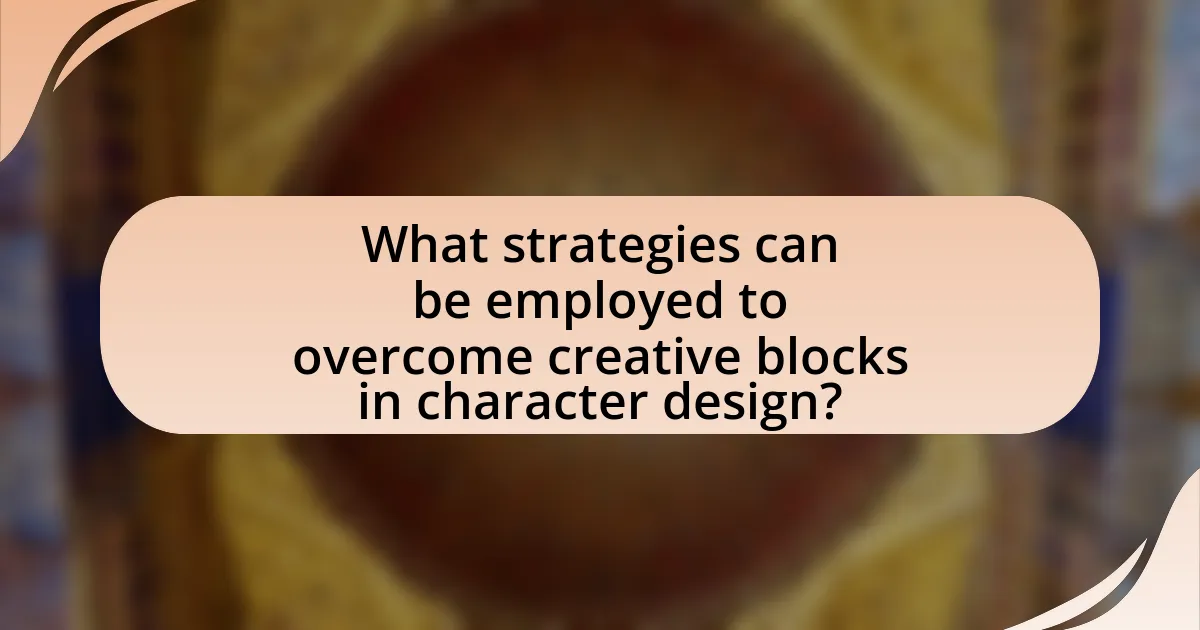
What strategies can be employed to overcome creative blocks in character design?
To overcome creative blocks in character design, artists can employ strategies such as brainstorming, changing the environment, and seeking inspiration from various sources. Brainstorming allows designers to generate a multitude of ideas without self-censorship, which can lead to unexpected and innovative character concepts. Changing the environment, such as working in a different location or rearranging the workspace, can stimulate creativity by providing new perspectives. Additionally, seeking inspiration from diverse sources, including art, literature, and nature, can help break the monotony and spark new ideas. These strategies are supported by studies indicating that varied stimuli and collaborative brainstorming enhance creative output and problem-solving abilities in artistic fields.
How can artists cultivate a creative mindset?
Artists can cultivate a creative mindset by engaging in regular practice, exploring diverse influences, and maintaining an open attitude towards experimentation. Regular practice enhances skills and fosters familiarity with various techniques, which can lead to innovative ideas. Exploring diverse influences, such as different art forms, cultures, and mediums, broadens perspectives and inspires new concepts. Maintaining an open attitude towards experimentation encourages artists to take risks and embrace failures as learning opportunities, ultimately leading to greater creativity. Research indicates that a growth mindset, characterized by the belief that abilities can be developed through dedication and hard work, significantly contributes to creative success in artistic endeavors.
What techniques can help in brainstorming new character ideas?
Techniques that can help in brainstorming new character ideas include mind mapping, character questionnaires, and role-playing scenarios. Mind mapping allows creators to visually organize thoughts and connections related to character traits, backgrounds, and motivations, facilitating the generation of diverse ideas. Character questionnaires prompt detailed exploration of a character’s personality, history, and relationships, which can lead to richer character development. Role-playing scenarios enable creators to embody their characters in various situations, revealing unique traits and behaviors that can inspire new ideas. These techniques are effective as they encourage creativity and provide structured approaches to character development, making it easier to overcome creative blocks.
How does setting specific goals aid in overcoming creative blocks?
Setting specific goals aids in overcoming creative blocks by providing clear direction and measurable outcomes. When individuals establish precise objectives, they can focus their efforts on achievable tasks, which reduces feelings of overwhelm and uncertainty that often accompany creative stagnation. Research indicates that goal-setting enhances motivation and accountability, leading to increased productivity. For instance, a study published in the “Journal of Applied Psychology” by Locke and Latham found that specific and challenging goals lead to higher performance compared to vague or easy goals. This structured approach allows creators to break down their projects into manageable steps, facilitating progress and ultimately fostering creativity.
What role does feedback play in overcoming creative challenges?
Feedback plays a crucial role in overcoming creative challenges by providing external perspectives that can identify strengths and weaknesses in a creative work. This external input helps individuals refine their ideas, leading to improved outcomes. For instance, studies show that constructive feedback can enhance creative performance by up to 30%, as it encourages iterative thinking and problem-solving. By integrating feedback, creators can navigate obstacles more effectively, fostering innovation and enhancing the overall quality of their character designs.
How can constructive criticism enhance character design skills?
Constructive criticism enhances character design skills by providing specific feedback that identifies strengths and weaknesses in a designer’s work. This feedback allows designers to understand how their designs resonate with audiences and where improvements can be made. For instance, critiques can highlight aspects such as character proportions, color choices, or emotional expression, which are crucial for effective character design. Research indicates that feedback from peers and mentors can lead to significant skill development, as it encourages designers to refine their techniques and explore new ideas, ultimately fostering creativity and innovation in their work.
What are effective ways to seek feedback from peers?
Effective ways to seek feedback from peers include organizing structured feedback sessions, utilizing online collaboration tools, and asking specific questions about your work. Structured feedback sessions, such as workshops or critique groups, create a focused environment where peers can provide targeted insights. Online collaboration tools like Google Docs or Slack facilitate real-time feedback and allow for easy sharing of work. Asking specific questions, such as “What do you think about the character’s design choices?” encourages detailed responses and helps clarify areas for improvement. Research shows that structured feedback can enhance creative output, as highlighted in studies on peer review processes in creative fields.
How can artists utilize exercises to break through creative blocks?
Artists can utilize exercises such as free drawing, timed sketches, and prompts to break through creative blocks. These exercises stimulate creativity by encouraging spontaneous expression and reducing the pressure of perfection. For instance, free drawing allows artists to explore ideas without constraints, while timed sketches can help them focus on capturing the essence of a subject quickly, fostering a sense of urgency that can spark new ideas. Additionally, using prompts can challenge artists to think outside their usual themes, leading to unexpected creative breakthroughs. Research indicates that engaging in varied artistic exercises can enhance cognitive flexibility, which is crucial for overcoming creative obstacles.
What are some practical exercises for enhancing creativity in character design?
Practical exercises for enhancing creativity in character design include sketching daily, utilizing prompts, and engaging in collaborative brainstorming sessions. Daily sketching encourages the development of unique styles and ideas, as artists often discover new concepts through regular practice. Utilizing prompts, such as “design a character based on a specific emotion,” stimulates creative thinking by providing a focused challenge. Collaborative brainstorming sessions with peers can lead to diverse perspectives and innovative ideas, as group dynamics often inspire individual creativity. These exercises are supported by studies indicating that consistent practice and collaboration significantly enhance creative output in artistic fields.
How can routine changes stimulate creative thinking?
Routine changes can stimulate creative thinking by disrupting established patterns and encouraging new perspectives. When individuals alter their daily habits, they expose themselves to different stimuli and experiences, which can lead to innovative ideas. Research indicates that engaging in novel activities enhances cognitive flexibility, allowing for more diverse thought processes. For instance, a study published in the journal “Psychological Science” by Oppezzo and Schwartz found that walking, a simple change in routine, significantly improved creative performance. This evidence supports the notion that routine changes can effectively foster creativity by promoting mental adaptability and openness to new concepts.
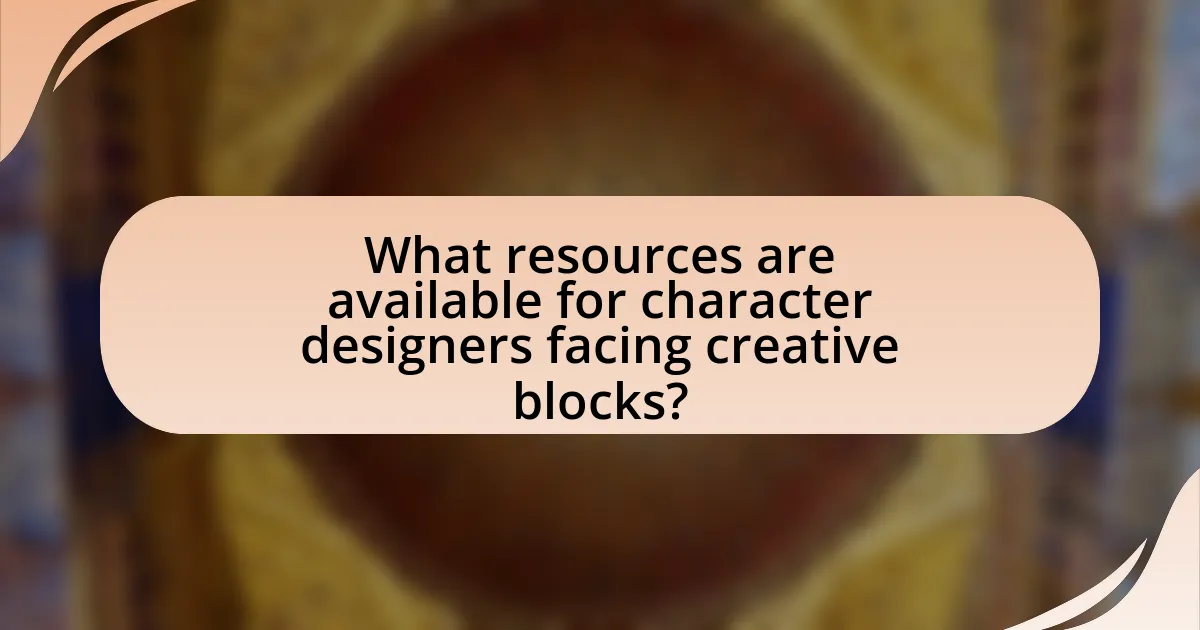
What resources are available for character designers facing creative blocks?
Character designers facing creative blocks can utilize various resources such as online communities, creative prompts, and design tools. Online platforms like ArtStation and DeviantArt provide forums for feedback and inspiration, while websites like Pinterest and Behance offer visual references and creative prompts to stimulate ideas. Additionally, tools like Adobe Fresco and Procreate can facilitate experimentation with different styles and techniques, helping designers break through mental barriers. These resources are effective as they foster collaboration, provide diverse perspectives, and encourage exploration, which are essential for overcoming creative stagnation.
What online platforms offer support for character designers?
Online platforms that offer support for character designers include ArtStation, DeviantArt, and Behance. ArtStation provides a community for artists to showcase their work, receive feedback, and connect with industry professionals, making it a valuable resource for character designers. DeviantArt allows users to share their art, participate in contests, and engage with a large community, fostering collaboration and inspiration. Behance serves as a portfolio platform where designers can display their projects and gain visibility, which is crucial for networking and career opportunities in character design.
How can social media communities assist in overcoming creative blocks?
Social media communities can assist in overcoming creative blocks by providing a platform for collaboration, feedback, and inspiration. These communities enable artists to share their work, receive constructive criticism, and engage in discussions that can spark new ideas. For instance, platforms like Instagram and Twitter host numerous art challenges and hashtags that encourage participation and creativity, fostering a sense of belonging and motivation among members. Research indicates that social interaction and peer support can enhance creative output, as seen in studies highlighting the positive impact of collaborative environments on artistic endeavors.
What role do online courses play in enhancing character design skills?
Online courses significantly enhance character design skills by providing structured learning, expert guidance, and access to diverse resources. These courses often cover fundamental principles of design, anatomy, and color theory, which are essential for creating compelling characters. For instance, platforms like Coursera and Udemy offer courses taught by industry professionals, allowing learners to gain insights from real-world experiences. Additionally, online courses often include practical assignments and feedback mechanisms, enabling students to apply their knowledge and refine their skills through iterative practice. This combination of theoretical knowledge and practical application is crucial for overcoming creative blocks and advancing in character design.
What books and materials can inspire character designers?
Books and materials that can inspire character designers include “Creating Characters with Personality” by Tom Bancroft, which provides insights into character development and design principles. Additionally, “The Art of Character” by David Corbett offers techniques for crafting compelling characters through storytelling. Visual reference books like “Character Design from the Ground Up” by Kevin Crossley and “The Character Design Book” by Steve A. Smith are also valuable resources, as they showcase various styles and approaches to character creation. These texts are widely recognized in the field and serve as essential tools for overcoming creative blocks in character design.
Which books are highly recommended for overcoming creative challenges?
“Steal Like an Artist” by Austin Kleon is highly recommended for overcoming creative challenges. This book emphasizes the importance of inspiration and encourages readers to embrace influence from others while developing their unique voice. Another notable book is “The Artist’s Way” by Julia Cameron, which provides a structured approach to unlocking creativity through exercises and reflections. Additionally, “Creative Confidence” by Tom Kelley and David Kelley focuses on fostering a creative mindset and overcoming self-doubt, making it a valuable resource for those facing creative blocks. These books are widely recognized in the creative community for their practical advice and insights into enhancing creativity.
How can reference materials aid in the character design process?
Reference materials significantly aid in the character design process by providing visual inspiration and context for designers. They help clarify design choices, such as color palettes, clothing styles, and anatomical proportions, which can enhance the overall quality and coherence of the character. For instance, artists often use photographs, illustrations, and concept art as references to ensure accuracy and creativity in their designs. Studies show that utilizing reference materials can reduce creative blocks by offering concrete examples that stimulate ideas and facilitate the exploration of different design possibilities.
What are some best practices for maintaining creativity in character design?
To maintain creativity in character design, artists should regularly engage in diverse sources of inspiration, such as art, literature, and nature. This practice broadens their perspective and introduces new ideas, which can lead to innovative character concepts. Additionally, setting aside dedicated time for brainstorming and sketching without constraints encourages free thinking and exploration of unconventional designs. Research indicates that creative individuals often benefit from structured routines that include breaks, as these pauses can enhance cognitive flexibility and idea generation. Furthermore, collaborating with other artists can provide fresh viewpoints and constructive feedback, fostering a more dynamic creative process.
How can regular practice help in preventing creative blocks?
Regular practice can help in preventing creative blocks by fostering a consistent flow of ideas and enhancing skill proficiency. Engaging in regular creative activities builds neural pathways associated with creativity, making it easier to generate new concepts. Research indicates that habitual practice can lead to increased confidence and reduced anxiety, which are common contributors to creative blocks. For instance, a study published in the journal “Psychology of Aesthetics, Creativity, and the Arts” found that artists who practiced regularly reported higher levels of creative self-efficacy, which directly correlates with the ability to overcome obstacles in the creative process.
What tips can artists follow to sustain their creative flow?
Artists can sustain their creative flow by establishing a consistent routine, engaging in regular practice, and seeking inspiration from various sources. A structured schedule helps artists dedicate specific time to their craft, which can enhance productivity and creativity. Regular practice, even in short bursts, allows artists to refine their skills and maintain momentum. Additionally, exploring different art forms, nature, or other artists’ work can provide fresh perspectives and ideas, preventing stagnation. Research indicates that diverse experiences can stimulate creativity, as shown in studies by the American Psychological Association, which highlight the benefits of varied stimuli in enhancing creative problem-solving abilities.
